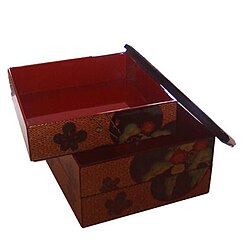Nest of boxes
The nest of boxes (じゅうばこ) is repeated to five folds from two folds, and it is a box to put the dish on a day of the fine weather that attached a cover to the halfpace in [1]. It is said that a quadruplet to express the four seasons is official. I call the fourth step "重 of 与" by four character evasion.
As for the shape, a square is common, but there are a circle and hexagon, the octagonal thing. It is used the lunches such as New Year dishes, cherry blossom viewing or the athletic meet of New Year holidays for a container of the eel and rice in a lacquered box again mainly today.
I am often made with a wooden article and the material such as lacquerware, the synthetic resin. There are the things made with paper thing and ceramics among them. "Figure of lacquer work plum camellia Wakamatsu nests of boxes" of Kourin Ogata are famous for artworks.
There is the portable tableware (portable tableware, portable tableware) which I hang it and attach a handle to the nest of boxes and was able to carry [1].
Table of contents
History
Because I can already read the description of "the nest of boxes" in documents of the Muromachi era, it is thought that the history is considerably old.
A nest of boxes is made of (1610) in earnest in the Edo era, and what I spread to the people at large is after. With a samurai family and the daimyo, the luxurious thing of lacquering and the lacquer work was made. In addition, the thing which was convenient for carrying around was used when I went for hunting.
Containers (so-called lunch box) by new material such as polypropylene spread, and the opportunity to see it gradually decreases recently.
The thing which was a Chinese meal basket (じきろう, hexagon and octagonal container to repeat it, and to use) was transmitted formerly in Japan and became the nest of boxes [2].
Production center
The nest of boxes made with lacquerware varies in a name by the production center. The main lacquerware product grounds are as follows.
- Tsugaru lacquering (Hirosaki, Aomori)
- 秀衡塗 (Morioka, Iwate)
- 能代春慶 (Noshiro, Akita)
- Kawatsura lacquerware (Akita Inagawa)
- Honjo lacquerware (Honjo, Akita)
- Clapper lacquerware (Miyagi clapper)
- Sendai lacquerware (Sendai, Miyagi)
- Kitakata lacquerware (Kitakata, Fukushima)
- Aizu lacquering (Aizuwakamatsu, Fukushima)
- 粟野春慶 (Katsura, Ibaraki)
- Sunlight lacquerware (Nikko, Tochigi)
- Tokyo lacquerware (Tokyo)
- Kamakura carving (Kamakura, Kanagawa)
- Shibayama lacquerware (Yokohama, Kanagawa)
- Odawara lacquerware (Odawara, Kanagawa)
- Murakami thickly-coated red lacquer ware with patterns carved in relief (Murakami, Niigata)
- Niigata lacquerware (Niigata, Niigata)
- Kiso lacquerware (Tarukawa, Nagano)
- Takaoka lacquerware (Takaoka, Toyama)
- Castle edge lacquerware (Toyama Castle edge)
- Uozu lacquerware (Uozu, Toyama)
- Kanazawa lacquerware (Kanazawa, Ishikawa)
- Wajima lacquering technique (Wajima, Ishikawa)
- Mountains lacquerware (Ishikawa mountains)
- Echizen lacquerware (Sabae, Fukui)
- Wakasa coat (Obama, Fukui)
- Hida Shunkei (Takayama, Gifu)
- Shizuoka lacquerware (Shizuoka, Shizuoka)
- Kyoto container (Kyoto)
- Kishu coat (Kainan, Wakayama)
- Nara lacquerware (Nara, Nara)
- Crow castle carving (Okayama, Okayama)
- Yakumo coat (Izumo, Shimane)
- Ouchi coat (Yamaguchi, Yamaguchi)
- Kagawa lacquerware (Takamatsu, Kagawa)
- Sakurai lacquerware (Imabari, Ehime)
- Tosa ancient times coat (Kochi, Kochi)
- Indigo plant womb lacquerware (Kurume, Fukuoka)
- Miyazaki lacquerware (Miyazaki, Miyazaki)
- Hita lacquerware (Hita, Oita)
- Ryukyu lacquerware (Naha, Okinawa)
Proverb
- 穿 (ほじ) comes with a toothpick by the corner of the nest of boxes.
- 穿 comes by the corner of the nest of boxes (it is said, "I find the corner of the nest of boxes").
Footnote
- ^ a b portable tableware, nest of boxes Sekigahara-cho Historical Museum
- ^ Yahoo! encyclopedia
Allied item
This article is taken from the Japanese Wikipedia Nest of boxes
This article is distributed by cc-by-sa or GFDL license in accordance with the provisions of Wikipedia.
In addition, Tranpedia is simply not responsible for any show is only by translating the writings of foreign licenses that are compatible with CC-BY-SA license information.



0 개의 댓글:
댓글 쓰기